Joruri in British Library
I am very happy to tell you that a Joruri performance was done in the British
Library last June.
My friend Ms Naruko Dayu, a Joruri chanter, was one of the mission members.
She told me about the meaningful trip to London.
How I wished I could have gone with them!
Here is some information as for the performance in London.
|
The Old Puppet Joruri:
The Tale of High Priest Kochi
|
At the end of the 17th century, ningyo joruri, alongside kabuki, was the
most popular form of entertainment among ordinary people. It was during
this time, in 1685, that the ningyo Joruri play the Tale of High Priest
Kochi was performed at the Sekkyo-za theatre in Nihonbashi in Edo (now
Tokyo).
Although Japan was cut off from the world during the Edo period, it did
trade with the Netherlands.The Dutch trading post was located in Nagasaki.
A German doctor and natural historian by the name of Kaempfer put the play
text in the bottom of his luggage when he left the country by ship in 1692.
Eventually, with no text existing in Japan, the joruri was lost.
More than 300 years later, in 1962, the play text was discovered in the
British Museum Library by Professor Torigoe Bunzo, Waseda University, who
was teaching medieval Japanese theatre at Cambridge University.
Joruri, which first appeared in the middle ages, developed into a form
of puppet theatre with the spreading popularity of the shamisen. The end
of the 17th century saw the arrival of Chikamatsu Monzaemon, dubbed 'the
Shakespeare of Japan.' His plays captured the hearts of audiences and the
popularity of ningyo joruri as entertainment rocketed.
Pre-Chikamatsu old joruri tends to be compared unfavourably to the mature
literature of Chikamatsu, but it is hard to dismiss the appeal of the simple
yet powerful songs and story structure that reflect the genuine emotions
of ordinary people.
This story is based on the legend of High Priest Kochi, Japan's oldest
self-mummified monk, who is enshrined in Saihoji Temple in Nagaoka City,
Niigata Prefecture. It tells the High Priest's life story, with added fictional
elements.
The story goes as follows:
The son of a powerful family living a life of debauchery, instigates a
fight over a trivial matter, which results in the death of his wife. This
prompts him to leave home and head for the sacred Mt Koya. En route, he
encounters a demon disguised as a beautiful woman who tries to hinder his
religious training and fights with her. After seven years of training he
returns to his hometown, helps his wife's spirit attain Buddhahood and
self mummifies.
The Tale of High Priest Kochi, told as a joruri in six acts, is a valuable
play that vividly depicts the view of the ordinary people of the time towards
religion and life.
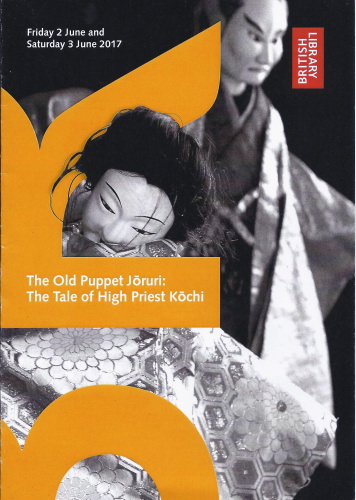 |
|
|
This work was specially commissioned by The Japan Foundation to The London
Performance Implementation Committee.
Organizers
The Japan Foundation and the British Library
Implementation
The London Performance Implementation Committee for
The Old Puppet Joruri: The Tale of High Priest Kochi
Committee Chair: Professor Donald Keene
Vice-chair: Professor Torigoe Bunzo
Administrative Chief: Nakamura Ikukazu (Legal Counsel to Donald Keene)
About the Japan Foundation
The Japan Foundation, established in 1972, is an institution dedicated
to carrying out comprehensive international cultural exchange programs
throughout the world, organizing projects and providing financial support
through grant programs in the fields of Arts and Culture, Japanese Language
and Japanese Studies. The Japan Foundation has its Head Office in Tokyo,
and has offices and centres in over 20 countries across the world.
The Japan Foundation London is the Foundation's only office in the UK.
|
|
Here are some photos which Naruko-dayu showed me.
Please enjoy.
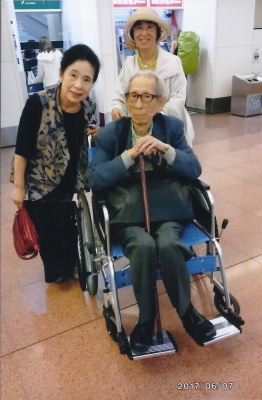 |
Naruko-dayu with Professor Torigoe Bunzo |
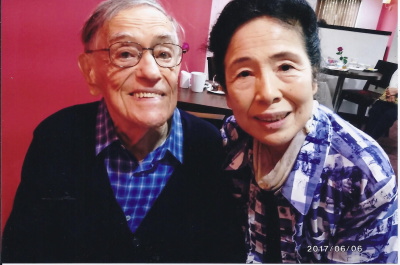 |
Naruko-dayu with Professor Donald Keene |
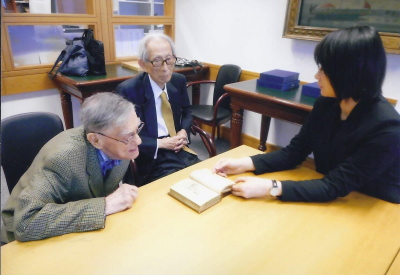 |
Professor Keene and Professor Torigoe looking at the original play
text of the story at the British Library.
This text has been lost in Japan for long, but was found by Professor Torigoe
at the British Library more than 300 years later. Professor Torigoe was
teaching Japanese culture at Cambridge University at that time (50 years
ago). |
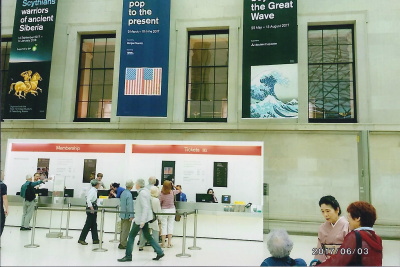 |
At the reception |
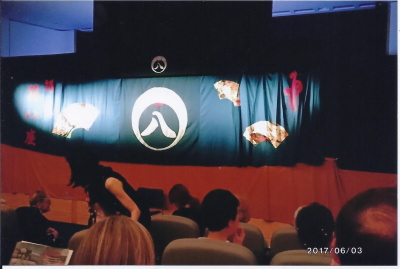 |
Stage curtain with the mark of the puppet master Hachirobe. |
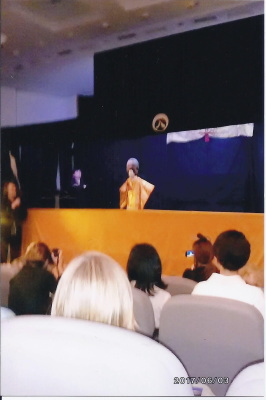 |
The performance stage |
 |
The mission people |
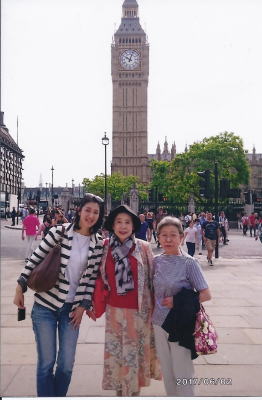 |
a short sightseeing trip before the performance. |
 |
Went also to see The Globe Theatre.
The joruri writer Chikamatsu was always compared to Shakespeare.
The stories of love and sorrow, hatred and revenge, always brought tears
to people's eyes.
Joruri is an art of emotion. Not ethics, not logics.
Naruko-dayu's impression in London was that Joruri also can meet the world
like Shakespeare's plays.
She said this important opportunity made her a new life as a chanter of
emotion.
Thank you, London! |
|
|
Thank you for your visit.
Looking forward to seeing you next month again.
Harumi Okochi
Proprietress
Yoyokaku
mail to: info@yoyokaku.com
|
|